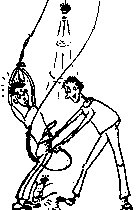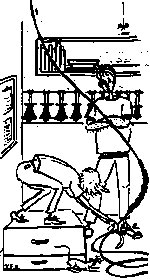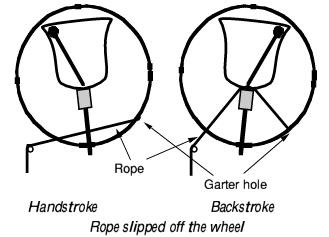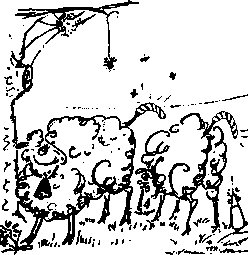The Tower Handbook
5.4 Ropes
a: Why are bells with long draughts harder to ring?
There are two main reasons, increased give in the rope and the dynamics of the rope in flight. Some towers suffer more from one than the other.
The springy rope problem is worst with hemp or flax ropes, and very bad with new ropes. A springy rope makes it harder to feel what the bell is doing. It is also harder to apply controlled force to the bell. As you pull the rope it initially stretches, tempting you to pull harder. Meanwhile the energy stored in the springy rope is being applied to the bell, and by the time you feel the bell over responding, it is too late to 'un-pull'. In extreme cases an oscillation will build up between you and the bell, which causes the rope to move jerkily rather than smoothly. Fitting pre-stretched polyester top ends helps. You can pre-stretch natural fibre ropes before you fit them, see section 14.8r. Beyond that the only way to reduce the problem is to train yourself to handle springy ropes, especially learning not to over react and jerk the rope.
The height of the first rope guide has a big effect on rope movement. When you ring, any small irregularities in the movement of your hands are amplified by the rope during the period while it is slack. The longer the free length of rope, the more this happens. If your handling is untidy, the movement can become so large that you are not sure where the sally will be when you should catch it. Chasing it will quite likely cause further movement which then gets amplified at the following stroke.
A long length of rope above the guide can cause further problems. Lateral rope movement near the guide causes extra friction that slows the rope as it passes through, and can lead to loops of slack rope forming above the guide. This makes the rope movement even more uncertain. Drawn [32] ropes will also aggravate the problems of free rope below. You can minimise these problems by ringing with long, straight vertical strokes that keep the rope taut for as much of the stroke as possible, with minimal lateral hand movement while the rope is slack.
Finally, all these problems can combine to undermine a ringer's confidence if he or she is a little uncertain. Psychological pressures can sometimes do more to disrupt handling than physical problems.
b: Can you have bells with no draught at all?
This may sound a silly question, but since long draughts cause problems, you may wonder whether it would be best to go to the other extreme and have no draught at all, ie to have the bells immediately above the ringers. There are limits on how far this is practical. The ringing room ceiling must be high enough to clear a tall ringer's hands but could the bell frame be just above this? It is physically possible, but not very practical. At backstroke, the sally rises quite a long way and would need to pass through the ground pulleys and round the bell wheel. If you have ever fitted a new rope, you will know that most sallies only just pass through the ground pulley block and so would stick in it while ringing. The minimum practical height of the frame is therefore determined by the height to which the sallies rise and this in turn depends on the size of the wheels.
c: What is a drawn rope?
Ideally the ropes all run vertically from bell to ringer. But there are constraints, especially in a small tower. In most towers, there is not enough space to lay the bells out in a neat pattern. The bell pits have to be fitted together like a jigsaw puzzle. The rope can come down in four positions [33] in each pit. Given this choice the ropes can normally be made to fall in roughly the right order, but rarely in a good circle. Some will be close together, others far apart. Some may be near the wall, others not.
For a good rope circle in the ringing room (which everyone agrees is a good thing), some of them must be drawn out of the vertical as they run down, hence the term 'drawn ropes'. For a small displacement the guides are merely moved a little. For a large displacement, the rope is provided with a sloping board (a runner board) or some form of chute to guide it on the sloping part of its run, with pulleys at the bends.
d: What makes ropes fly around?
 The main cause of ropes snaking about is untidy handling. Small movements of the hands are amplified by the moving rope which can sometimes sweep out in quite large arcs. The run of the rope has an effect. Long draughts make any problems worse by amplifying tiny disturbances to the rope.
The main cause of ropes snaking about is untidy handling. Small movements of the hands are amplified by the moving rope which can sometimes sweep out in quite large arcs. The run of the rope has an effect. Long draughts make any problems worse by amplifying tiny disturbances to the rope.
Drawn ropes are particularly troublesome and can make it difficult for even a good handler. The rope above the guides runs at an angle and its momentum tends to keep it going in the same direction after passing through the guide, so it shoots out sideways.
When ringing such a bell, handle the rope smoothly - no little flicks or jerks to add to what the rope will do anyway.
If the rope is heavily drawn you won't be able to prevent all the sideways movement of the rope, since even with a long, straight stroke there will be a period when you have no tension on the rope (other than its weight). The best you can do is to reduce the effect by minimising the time when the rope is not taut, and ringing as tidily as possible.
e: Why do some towers have the ropes anti-clockwise?
We could equally ask why so many have the ropes hung clockwise.
f: Does it make any difference which order the ropes hang?
The ropes are arranged in sequence (either clockwise or anti clockwise) in almost all towers, so it is easier to remember which is which, and which order they should ring in rounds. Strictly, once the bells are ringing changes, it should not matter, but it helps to know which is which if anyone needs to be given assistance.
g: Why do some big bells have very large boxes for everyone?
 It's certainly not so they can be rung by midgets! Heavy bells have bigger wheels to give the rope more leverage. But because the bigger wheel has a larger circumference, more rope winds and unwinds round it when the bell swings. If the bell were rung from the floor as normal, this extra rope would fall in an untidy pile and twist and jerk as it was drawn up again. But if the bell is rung from a box the extra distance to the floor lets the rope hang more freely [34].
It's certainly not so they can be rung by midgets! Heavy bells have bigger wheels to give the rope more leverage. But because the bigger wheel has a larger circumference, more rope winds and unwinds round it when the bell swings. If the bell were rung from the floor as normal, this extra rope would fall in an untidy pile and twist and jerk as it was drawn up again. But if the bell is rung from a box the extra distance to the floor lets the rope hang more freely [34].
In the old days, boxes for large bells were often fixed to the floor and fitted with leather straps for the ringer to put his [35] foot under. This enabled him to pull harder without being lifted off his feet.
h: What happens when a rope slips wheel?
 The rope winds one way then the other round the wheel. At backstroke it winds over half way round. If moved sideways as it switches from one direction to the other it can slip out of the channel round the wheel that keeps it in place. Normally the weight of the rope keeps it taut and stops this happening but if the rope goes slack it can form a loop. This is more likely with a short draught, if you ring with a slack rope, or if there is friction or snagging in the rope run.
The rope winds one way then the other round the wheel. At backstroke it winds over half way round. If moved sideways as it switches from one direction to the other it can slip out of the channel round the wheel that keeps it in place. Normally the weight of the rope keeps it taut and stops this happening but if the rope goes slack it can form a loop. This is more likely with a short draught, if you ring with a slack rope, or if there is friction or snagging in the rope run.
If the rope slips wheel, the rope comes off as the garter hole goes past the ground pulley and then gets pulled across the wheel instead of round it as the bell turns. From below you see the rope almost stop in mid stroke. A couple of seconds later it may suddenly move rapidly upwards again if it jumps back on the wheel as the garter hole returns past the pulley. Alternatively, it may stay off and you will not be able to ring the bell, though as the diagram shows, you could still exert some force at hand stroke (so long as you know which is the handstroke). Sometimes the bell may set itself while the rope is off the wheel.
i: What is a Yorkshire tail end?
 In some Yorkshire towers the tail end of the rope is fitted with a second sally (sometimes called a billy) that is shorter and thinner than the main one.
In some Yorkshire towers the tail end of the rope is fitted with a second sally (sometimes called a billy) that is shorter and thinner than the main one.
Supporters of this practice claim that holding the billy is more comfortable than holding a doubled-back tail end. The disadvantages are that you are more likely to have to adjust the length of rope below the sally [36] but it is more difficult. There are no tucks to adjust, so you have to use knots in the rope.
Making the ropes is also more difficult, because the amount of rope below the sally has to be carefully calculated to match the size of the bell's wheel. Perhaps this is why Yorkshire tail ends are less common than they were a century ago.
j: What is a splice?
The term is used in two ways. A splice joins two pieces of rope without the lumps that a knot would produce. It makes the rope a little thicker near the join, but not enough to impede its movement through ceiling bosses and pulleys.
Splicing also describes a way of joining methods in a touch. All the ringers change from one method to another at the same time, usually at the treble's backstroke lead. Method splicing was introduced so extents of Doubles, Minor and Triples could be rung in several methods. See section 4.1p.
k: Why are most sallies striped?
A striped sally is more visible when moving against a variety of backgrounds than one in a single colour. When making a rope it is easy to insert different coloured wool in each strand of the rope, which is why most sallies are in three colours. You may occasionally see four stranded ropes, but they are usually still three coloured with one colour appearing twice, eg red, blue, white, white, etc. or red, white, blue, white, etc.
Previous

 Next
Next
Currently hosted on jaharrison.me.uk
 The main cause of ropes snaking about is untidy handling. Small movements of the hands are amplified by the moving rope which can sometimes sweep out in quite large arcs. The run of the rope has an effect. Long draughts make any problems worse by amplifying tiny disturbances to the rope.
The main cause of ropes snaking about is untidy handling. Small movements of the hands are amplified by the moving rope which can sometimes sweep out in quite large arcs. The run of the rope has an effect. Long draughts make any problems worse by amplifying tiny disturbances to the rope. It's certainly not so they can be rung by midgets! Heavy bells have bigger wheels to give the rope more leverage. But because the bigger wheel has a larger circumference, more rope winds and unwinds round it when the bell swings. If the bell were rung from the floor as normal, this extra rope would fall in an untidy pile and twist and jerk as it was drawn up again. But if the bell is rung from a box the extra distance to the floor lets the rope hang more freely
It's certainly not so they can be rung by midgets! Heavy bells have bigger wheels to give the rope more leverage. But because the bigger wheel has a larger circumference, more rope winds and unwinds round it when the bell swings. If the bell were rung from the floor as normal, this extra rope would fall in an untidy pile and twist and jerk as it was drawn up again. But if the bell is rung from a box the extra distance to the floor lets the rope hang more freely  The rope winds one way then the other round the wheel. At backstroke it winds over half way round. If moved sideways as it switches from one direction to the other it can slip out of the channel round the wheel that keeps it in place. Normally the weight of the rope keeps it taut and stops this happening but if the rope goes slack it can form a loop. This is more likely with a short draught, if you ring with a slack rope, or if there is friction or snagging in the rope run.
The rope winds one way then the other round the wheel. At backstroke it winds over half way round. If moved sideways as it switches from one direction to the other it can slip out of the channel round the wheel that keeps it in place. Normally the weight of the rope keeps it taut and stops this happening but if the rope goes slack it can form a loop. This is more likely with a short draught, if you ring with a slack rope, or if there is friction or snagging in the rope run.  In some Yorkshire towers the tail end of the rope is fitted with a second sally (sometimes called a billy) that is shorter and thinner than the main one.
In some Yorkshire towers the tail end of the rope is fitted with a second sally (sometimes called a billy) that is shorter and thinner than the main one.